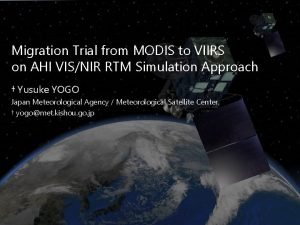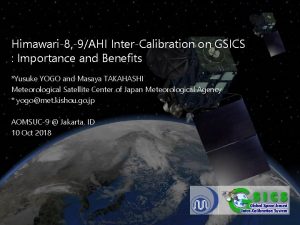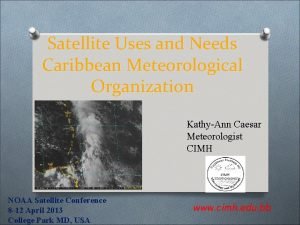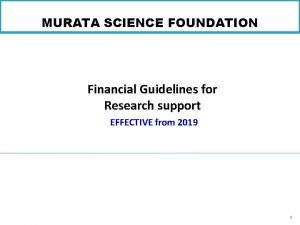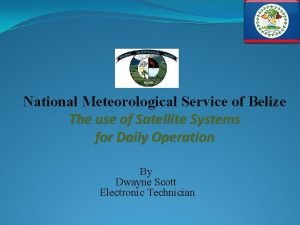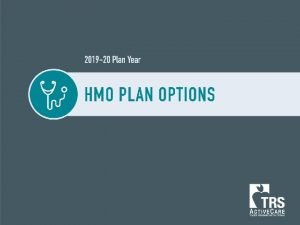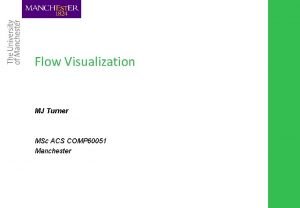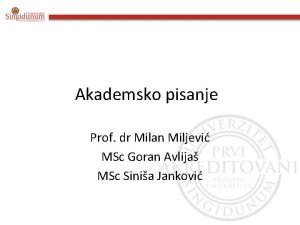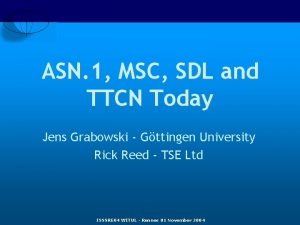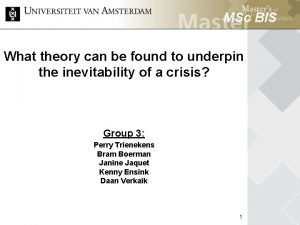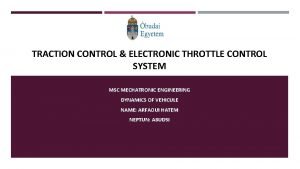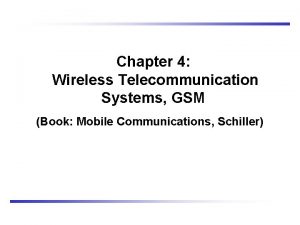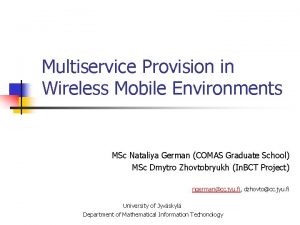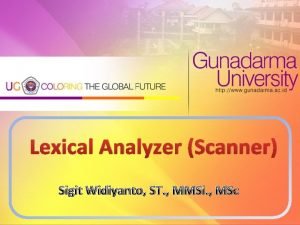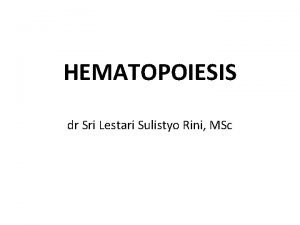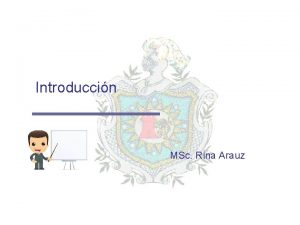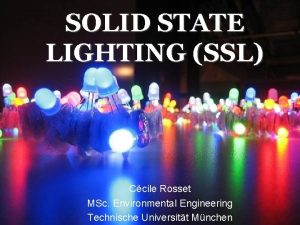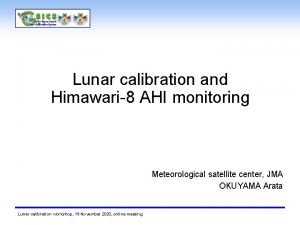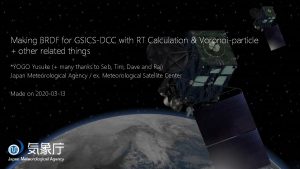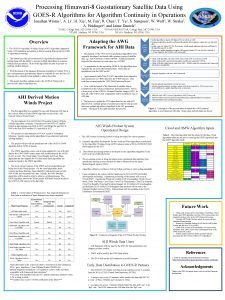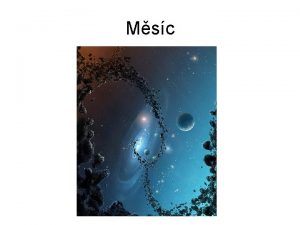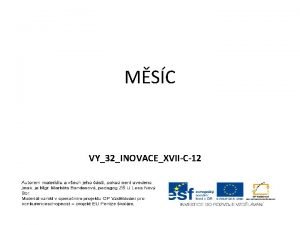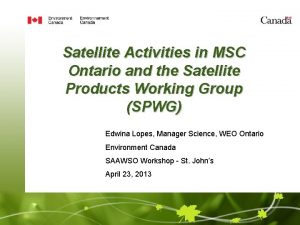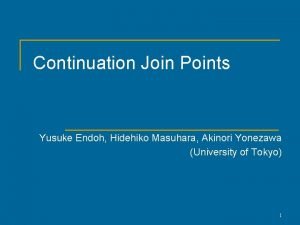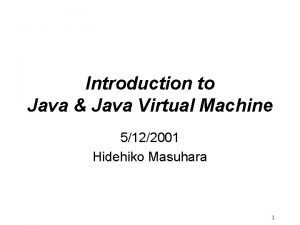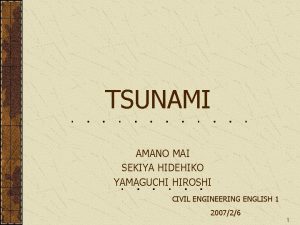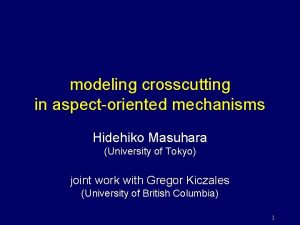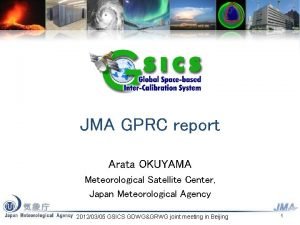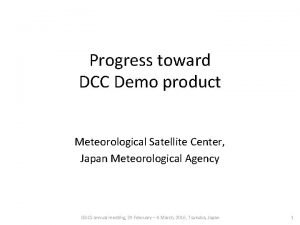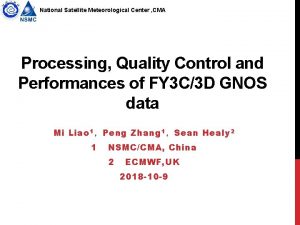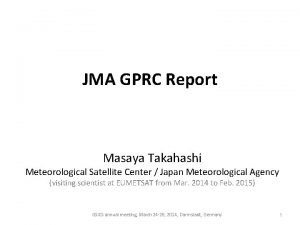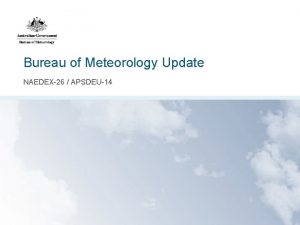Himawari8 Update Hidehiko MURATA Meteorological Satellite Center MSC




























- Slides: 28

Himawari-8 Update Hidehiko MURATA Meteorological Satellite Center (MSC) Japan Meteorological Agency (JMA)

Himawari-8/9 Schedule toward Operation 2015 2014 year/month 10 11 12 1 2 In-Orbit Test 100 -day Running Test Outgas Mode Normal Mode Satellite Bus IOT AHI Modes (AHI: Advanced Himawari Imager) - 7 October 2014: Himawari-8 launch 18 December 2014 : The first shot In-Orbit Test and 100 -day Running Test <- now April 2015 : Pre Operation mid-2015 : Full Operation 2016 : The launch of Himawari-9 Himawari-8/9 will be in operation around 140 degrees East. 3

Himawari-8 imagery around India

History of Japanese Geostationary Meteorological Satellites “Himawari” GMS (Geostationary Meteorological Satellite) GMS-2 (Himawari) (Himawari-2) GMS-3 GMS-5 GMS-4 (Himawari-3) (Himawari-4) (GOES-9) (Himawari-5) One of the tri-Ranging Station for GMS was operated by Australian Bureau of Meteorology Jul 1977 Aug 1981 Aug 1984 Sep 1989 Mar 1995 MTSAT (Multi-functional Transport SATellite ) MTSAT-1 R MTSAT-2 (Himawari-6) (Himawari-7) Himawari-8 Feb 2005 3 Feb 2006 2014 Back-up operation of GMS-5 with GOES-9 by NOAA/NESDIS May 2003 - June 2005 Himawari-9 2016 Satellite Observation period GMS 1977 – 1981 GMS-2 1981 – 1984 GMS-3 1984 – 1989 GMS-4 1989 – 1995 GMS-5 1995 – 2003 GOES-9 2003 – 2005 MTSAT-1 R 2005 – 2010 MTSAT-2 2010 – Himawari-8 Launch in 2014 Himawari-9 Launch in 2016 3

Himawari-8/9 AHI observations in 10 minutes time frame These “super-rapidscans” (every 30 seconds) will also be used for the lunar observations Full Disk Observation every 10 min. Region 3 Region 5 Region 2 Region 4 Region 1 (SW Japan) (Target Area) (Landmark Area) (NE Japan) Every 2. 5 min. Every 30 sec. EUMETSAT Calibration Club Meeting, 27 February, 2015 4

AHI specification Spatial Central # of Quantization Band Wavelength Resolution detectors of digital (*) count [bit] [μm] [km] 1 0. 47 1 676 (3) 11 2 0. 51 1 676 (3) 11 3 0. 64 0. 5 1460 (3) 11 4 0. 86 1 676 (6) 11 5 1. 6 2 372 (6) 11 6 2. 3 2 372 (6) 11 7 3. 9 2 332 (6) 14 8 6. 2 2 332 (6) 11 9 6. 9 2 332 (6) 11 10 7. 3 2 332 (6) 12 11 8. 6 2 332 (6) 12 12 9. 6 2 332 (6) 12 13 10. 4 2 408 (6) 12 14 11. 2 2 408 (6) 12 15 12. 4 2 408 (6) 12 16 13. 3 2 408 (6) 11 AHI Field of View Center (VNIR) ITT EXELIS(2013): AHI-8 EQUIPMENT MANUAL 2 CALIBRATION AND ALIGNMENT HANDBOOK Rev. J * Number of redundant detector columns per side 5

AHI (Advanced Himawari Imager) Ø 16 Bands (VIS: 3, NIR: 3, IR: 10), similar to GOES-R/ABI VIS/NIR spectral response function #1(0. 47) #2(0. 51) #3(0. 64) #4(0. 86) #5(1. 6) Himawari-8/AHI GOES-R/ABI Meteosat-10/SEVIRI #6(2. 3) 6

AHI (Advanced Himawari Imager) SWIR, WV, TIR #7(3. 9) Himawari-8/AHI GOES-R/ABI Meteosat-10/SEVIRI #10(7. 3) #9(6. 9) WV #14(11. 2) #15(12. 4) #12(9. 6) #11(8. 6) #16(13. 3) #13(10. 4) TIR #8(6. 2) 7

The First Images of Himawari-8 Band 01 (0. 47μm) Band 02 (0. 51μm) Band 03 (0. 64μm) Band 05 (1. 6μm) Band 06 (2. 3μm) Band 07 (3. 9μm) Band 08 (6. 2μm) Band 09 (6. 9μm) Band 10 (7. 3μm) Band 11 (8. 6μm) Band 12 (9. 6μm) Band 13 (10. 4μm) Band 14 (11. 2μm) Band 15 (12. 0μm) Band 16 (13. 3μm) Band 04 (0. 86μm) Dec. 18 2014 02: 40 UTC

Radiometric calibration/comparison of JMA GEO imagers GMS-5/VISSR (1995 -2003) Himawari-8/AHI (2015 -2022) Central Vicarious Albedo Black GSICS GEOWavelength method monitor Body (IR) (DCC) (Moon) GEO [µm] (RTM) 0. 72 6. 8 11. 0 12. 0 (Y) Y Y Y (Y) (Y) MTSAT-2/Imager (2010 -2015) Central Vicarious Albedo Black GSICS Ray GEOWavelen. method monitor Body (IR) (DCC) (Moon) matching GEO [µm] (RTM) 0. 68 Y Y 3. 8 (Y) Y Y Y (Y) Y 6. 8 Y Y (Y) Y 10. 8 Y Y (Y) Y 12. 0 Y Y (Y) Y Central Solar Wavelength Diffuser [µm] 0. 47 0. 51 0. 64 0. 86 1. 6 2. 3 3. 9 6. 2 6. 9 7. 3 8. 6 9. 6 10. 4 11. 2 12. 4 13. 3 Black Body Vicariou GSICS Ray s method (IR) (DCC) (Moon) matching (RTM) Y Y Y? Y? Y Y Y Y Y Y Y Y Y Y (Y) (Y) (Y) GEOGEO (Y) Y (Y) (Y) Y Y Y (Y) q Onboard calibration q Inter-calibration/comparison, vicarious calibration (Y): applicable, but not planned yet 9

Himawari-8/AHI lunar observation q The Moon acquisition by super-rapidscan mode / 30 sec • Performed based on the Moon position prediction • ~400 lunar observations applicable to GIRO in Dec 2014 and Jan 2015 (have been already shared w/ EUMETSAT) q Lunar observation net. CDF • Will be shared within the lunar calibration community q One swath for the Moon observation q Commissioning phase: Dec. 2014 - mid 2015 AHI VIS/NIR bands specification Central Spatial Levels # of Band Wavelength Resolution of DC detectors [km] [bit] [μm] 1 2 3 4 5 6 0. 47 0. 51 0. 64 0. 86 1. 6 2. 3 1 1 0. 5 1 2 2 676 1460 676 372 11 11 11 Time series of ΔIrr for Band 3 (0. 64 um) Band 5 (1. 6μm) 2015 -01 -12 T 08: 29 -18 -08: 34: 27 16 days 10

Ray-matching w/ S-NPP/VIIRS Ø Direct comparison of GEO and reference (i. e. , LEO) Ø Issues to be solved: spectral band adjustment • Estimation using ü Radiative transfer calculation ü Observation (e. g. , GOME-2) -> N/A to all bands • 0. 86, 2. 3µm: small SRF differences Simulated reflectivity over liquid cloud (AHI – VIIRS) 1. 6 um SRF AHI VIIRS/M 1. 6 um 1. 0 1. 5 Wavelength [µm] 2. 3 um 2. 0 2. 3 um 2. 5 11

GEO-LEO Ray matching with Suomi-NPP/VIIRS for VIS/NIR bands (2015/02/20) preliminary results data distribution band 1(0. 47) M 03 band 2(0. 51) M 03 band 3(0. 64) I 01 band 5(1. 6) M 10 band 6(2. 3) M 11 VIIRS AHI band 4(0. 86) M 07 AHI black: diagonal line red: expected line accounting for SRF difference blue: regression line B 01 B 02 B 03 B 04 B 05 B 06 SCIMACHY 0. 966 1. 052 1. 003 0. 991 0. 998 --- RSTAR 0. 975 1. 051 1. 002 0. 991 1. 004 1. 000 Slope of expected line accounting for SRF difference from 1) SCIMACHY (by NASA SBAF) 2) RSTAR (RTM) 12

Vicarious calibration using RTM Ø Method: Comparison of observed and simulated MTSAT-2/Imager in Feb. 2011 radiance for multiple targets (collaboration research Ø Targets: • Cloud-free ocean (rayleigh scattering) / land, liquid water cloud, and DCC Ø Radiative transfer calculation: • RSTAR (Nakajima and Tanaka [1986, 1988]) Simulated reflectivity with the University of Tokyo [Prof. Nakajima]) Ø Input data: Independent from GEO data • JMA Re-Analysis atmos. profiles (JRA-25/JCDAS) • Aerosol/Cloud optical thickness retrieved from MODIS L 1 B (MYD 02 SSH) • MODIS BRDF (MCD 43 C 2) for land target • Aura/OMI total column ozone, … Observed reflectivity Calibration results: combination of multiple targets! 13

Vicarious calibration using RTM B 01(0. 47) B 02(0. 51) Simulated 2015/02/27 05 UTC Aqua Observed ocean (rayleigh scattering) land liquid water cloud B 03(0. 64) B 04(0. 86) B 05(1. 6) B 06(2. 3) 14

Outlook with Next-generation GEO satellite • New capabilities of Next-generation GEO satellite for GSICS • Multi band – DCC (applying all VIS/NIR bands) – Inter-channel calibration • Frequent sampling – GEO-LEO diurnal variation – Lunar observation • Solar diffuser

Thank you! JMA/MSC appreciate collaborators to validate AHI commissioning dataset, especially for Dr. Fred Wu and Dr. Fangfang Yu in NOAA.

Backup

IR Calibration using blackbody (BB) 18 Equation for IR cal. using BB/space obs. q: Fixed (pre-launch calibration value) m: Derived from BB/space observation • a • regression using past 72 hours BB obs. • predictor of m: imager temperatures T • a For simplicity, this is the case for MTSAT-2/Imager (Theory is the same for Himawari-8/AHI) b: Derived from m/space observation

Incident radiance at the surface of NS scan mirror 19 BRDF of SD (measured by pre-launch tests): ITT EXELIS(2013): AHI-8 EQUIPMENT MANUAL 2 CALIBRATION AND ALIGNMENT HANDBOOK Rev. J

VIS/NIR calibration using solar diffuser (SD) 20 GMS/MTSAT satellites Himawari-8/9 • On-board calibration equipment called “albedo monitor” (e. g. , pinhole to introduce sunlight) • Optical path(s) of albedo monitor ≠ instrument • Calibration coefficients: never updated • Solar diffuser similar to MODIS • NO solar diffuser stability monitor • Operation: ~ every 2 weeks Time series of MTSAT-2 albedo monitor digital counts Earth view Digital count SD ~5%/year degradation w/ large uncertainty Jan 2006 Jan 2008 Jan 2010 Jan 2012 Jan 2014 (Courtesy of M. Sasaki) ITT EXELIS(2013): AHI-8 EQUIPMENT MANUAL 2 CALIBRATION AND ALIGNMENT HANDBOOK Rev. J

Himawari-8/AHI lunar calibration AHI VIS/NIR spec. 21 Central Spatial # of Levels Band Wavelength Resolution detectors of DC [km] (*) [bit] [μm] 1 0. 47 1 676 (3) 11 q The Moon acquisition: super-rapidscan / 30 sec 2 • Performed based on the Moon position prediction 3 4 • ~100 lunar observations / month are expected 5 q One swath for the Moon observation 6 q Commissioning phase: end of Nov. 2014~ q Lunar observation net. CDF • Will be shared within the community q Known issues to be considered • AHI “out of field response” (all VIS/NIR bands) 0. 51 1 676 (3) 11 0. 64 0. 5 1460 (3) 11 0. 86 1 676 (6) 11 1. 6 2 372 (6) 11 2. 3 2 372 (6) 11 ABI Fo. R (similar to AHI) Observation domain of super-rapidscan Moon Targeting observation size: ~0. 8 x 1. 6 [deg] Moon apparent diameter: ~0. 5 [deg] Gounder et. Al (2008): https: //ams. confex. com/ams/88 Annual/techprogram/paper_136061. htm

Himawari-8/9 ground segment and operations * Osaka

Himawari-8/9: Data Distribution/Dissemination New equipment needs to be installed. C-band antenna LNB DVB-S 2 receiver PC & software

Internet Cloud Service (Himawari. Cloud) Format Area Data size Remarks Himawari Full disk 329 GB (1 day) 930 MB (10 min) Standard Data Target area #3: #1, 2, 4: 230 MB (10 min) #5 -16: 60 MB (10 min) (HSD) - Full disk: every 10 minutes - Target area: every 2. 5 minutes - 16 bands - Finest-spatial-resolution data PNG Full disk 49 GB (1 day) Target area 350 MB (10 min) - True color image (composites of 3 visible bands) - Full disk: every 10 minutes - Target area: every 2. 5 minutes - Same spatial resolution as HSD Net. CDF Target area 12 GB (1 day) - Every 2. 5 minutes - 16 bands - Same spatial resolution as HSD #3: 8 MB (2. 5 min) #1, 2, 4: 2 MB (2. 5 min) #5 -16: 0. 5 MB (2. 5 min) Features n NMHS can get data using HTTP 1. 1 client such as Web browser or Wget. n NMHS choice of data (HSD is created separately for each band, and divided into 10 segments. ) i. e. 16 bands x 10 segments = 160 files / 10 minutes Notes n Basically one download per one country n Account registration is required n High speed Internet access (25 Mbps) is required to download all HSD

Archive Server: Candidates - Following two systems volunteered to act as a server for providing all Himawari-8 data to researchers - They have big storage device more than several peta bytes - Voluntary and best effort service - Details are undecided - Further news will be uploaded in JMA/MSC website DIAS Data Integration and Analysis System http: //www. editoria. u-tokyo. ac. jp/projects/dias/? locale=en - Managed by University of Tokyo NICT Science Cloud http: //sc-web. nict. go. jp/ - Managed by National Institute of Information and Communications Technology (NICT)

Diurnal variation problem on IR bands detected by GEO-LEO 2015/03/03 -07 Be Af fo te r re 2015/02/01 -28 (UTC)

AHI-8 Ground Test Results Dynamic range Radiometric calibration accuracy ICT emissivity Out-of-band response Test result Analysis Test result 585 120% 2. 63% - 0. 13% 645 135% 2. 53% - 0. 36% 459 165% 2. 55% - 0. 08% 420 205% 2. 39% - 0. 24% 912 121% 2. 73% - 0. 31% 688 132% 2. 82% - 0. 29% 300 K 116 401 K 0. 42% 99. 83% 0. 23% 11 240 K 190 317 K 0. 34% 99. 93% 0. 29% 0. 4019 11 300 K 1105 327 K 0. 29% 99. 90% 0. 43% 7. 3471 0. 1871 12 240 K 229 327 K 0. 24% 99. 93% 0. 49% 11 8. 5905 0. 3727 12 300 K 1265 344 K 0. 20% 99. 91% 0. 34% 12 9. 6347 0. 3779 12 300 K 1149 328 K 0. 21% 99. 92% 0. 27% 13 10. 4029 0. 4189 12 300 K 835 371 K 0. 23% 99. 98% 0. 36% 14 11. 2432 0. 6678 12 300 K 1105 348 K 0. 22% 99. 98% 0. 30% 15 12. 3828 0. 9656 12 300 K 867 403 K 0. 20% 99. 95% 0. 32% 16 13. 2844 0. 5638 11 300 K 363 410 K 0. 22% 99. 94% 0. 29% Center wavelength [mm] Bandwidth [mm] Test result 1 0. 4703 0. 0407 11 2 0. 5105 0. 0308 11 3 0. 6399 0. 0817 11 4 0. 8563 0. 0345 11 5 1. 6098 0. 0409 11 6 2. 257 0. 0441 11 100% Albedo 100% Albedo 7 3. 8848 0. 2006 14 8 6. 2383 0. 8219 9 6. 9395 10 Band SNR Bits Scene Center Wavelength: that of bandwidth Bandwidth: FWHM http: //www. data. jma. go. jp/mscweb/en/himawari 89/space_segment/doc/AHI 8_performance_test_en. pdf SNR: signal-noise ratio ICT (internal calibration target): internal black body target for calibration
 Jma msc
Jma msc Jma msc
Jma msc Ramsdis
Ramsdis Murata science foundation
Murata science foundation Immediate update and deferred update in dbms
Immediate update and deferred update in dbms National meteorological service of belize
National meteorological service of belize Swhp coverage update center
Swhp coverage update center Acs comp
Acs comp Milan miljevic
Milan miljevic Msc construction law
Msc construction law Vdoe msc
Vdoe msc Msc marianna
Msc marianna Msc
Msc Leontien ruttenberg
Leontien ruttenberg Msc dic
Msc dic Msc bis
Msc bis Nsozvn
Nsozvn Diverkasi
Diverkasi Msc finance and banking tor vergata
Msc finance and banking tor vergata Telecommunication systems book
Telecommunication systems book Msc pelago
Msc pelago Scan barcode msc
Scan barcode msc Phsc in erythropoiesis
Phsc in erythropoiesis Msc finance grenoble
Msc finance grenoble Msc direccionamiento
Msc direccionamiento 2vision msc
2vision msc Fibrinolysis pathway
Fibrinolysis pathway Msc sirkka
Msc sirkka Msc ssl
Msc ssl
